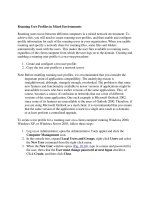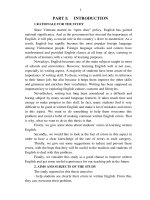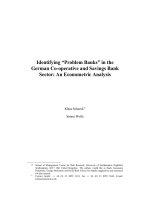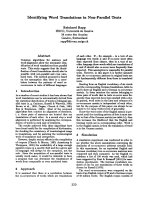identifying handwritten text in mixed documents
Bạn đang xem bản rút gọn của tài liệu. Xem và tải ngay bản đầy đủ của tài liệu tại đây (699.05 KB, 4 trang )
Identifying handwritten text in mixed documents
Faisal
Farooq
Karthik Sridharaii
Veiiu
Goviiidaraju
CEDAR. University at Buffalo
Arnherst.
NY,
USA.
14228
E-mail:
(ffarooq2. ks236,govind) @cedar. buffalo. edu
Abstract
In
thzs paper we present a system for
classzficatzon
of
machane pranted and handwratten
text
zn
mzxed doc-
uments. The classaficataon
as
performed
at
the word
level. We propose
a
feature extractzon algorzthm for
each word amage based
on
Gabor filters followed by
classzficatzon uszng an Expectatton
Maxamazataon(EM)
based probabalzstac neural network that reduces overfit-
tang
of traanang data.
An
overall precasaon of
94.62%
was obtaaned for the
Arabzc
scrzpt uszng the modafied
neural network. The accuraczes obtaaned uszng a
szm-
ple backpropagataon neural network and an
SVM
were
83.33%
and
90.26%
respectavely.
1
Introduction
The processing of document iniages prior to recog-
nition plays
a
significant part in the development of
Handwriting Recognition
(HR)
systems. In
a
docu-
ment that has both machine print and handwritten
text, it is important to distinguish between the two.
\Ye describe
a
method to identify handwritten words
in
a
document image using Arabic
as
a
representa-
tive script. This is because the task proves specially
challenging in Arabic because the script is cursive in
both machine print and handwriting. The accuracies
achieved in this script can very well be translated to
other scripts of similar nature.
In this paper we describe a method that extracts
texture features from word images. An
EN
based neu-
ral network is used for classification to deal with the
sparse training data that does not have representatives
from all fonts and writing styles.
2
Previous
Work
A neural network based classifier
was
suggested in
[8] that used nine texture features to distinguish ma-
Figure
1.
A
sample document
chine print from the handwritten text in bank checks.
Srihari et al.
[12]
describe a block separation method
where the classification is based on the frequency of the
heights of the different components in the segmented
block. It is assumed that a block with widely differ-
ing heights is handwritten and a block with uniform
component heights is machine printed.
A
rule based
approach was described by Pal aiid Chaudhari
[ll]
for
Devanagiri script. A similar approach
was
taken by
Guo and Ma [6] by using projection profiles. These
methods do not apply readily to other scripts. Zheng
et a1 [14] proposed using
a
mix of run-length, cross-
ing count, stroke orientation aiid texture features. Ex-
tracting all these features is
a
computationally expen-
sive task and we belieye that
a
minimal set of features
is required for the actual task. Our hypothesis is that
in handwriting, horizontal runs and gradients are not
as
uniform as in machine print. The advantage of our
method is that it can be implemented at the word level
as
it captures the local structure of components in the
document.
A
discrimination method that operates at
1
0-7695-2521-0/06/$20.00 (c) 2006 IEEE
where (x’.y’) are rotated components of
(x.y),
x’
=
xcosQ
+
ysznQ
i
y’
=
-xsinQ
+
ycosQ
and
F
is the radial frequency which for
a
given scale
s
is given by
F
=
Fo/s.
The output of the filter,
I
Figure
2.
Components
of
the system
the word level
was
described in [4]. using slope and
stroke width histograms. However, the method
was
not trainable and thresholds were selected empirically.
Figure
2
shows
a
block diagram of our approach.
It has 3 stages
:
(i)
word extraction (ii) feature ex-
traction and (iii) classification. In the word extraction
stage. we binarize
[lo]
the image and extract individual
word images from the document [3]. Each word image
is normalized by scaling to
a
fixed height while pre-
serving the aspect ratio, hence the width of the word
images vary. Directional Gabor filters are used to ex-
tract features from the word image. Classification is
performed by
a
probabilistic neural network which is
trained using an
El1
algorithm. This neural network
combines solutions according to their posterior distri-
bution to avoid overfitting based
on
the training data.
GQ.~(~.
y)
=
J’
I(s.
t)h~.~(x
-
s.
y
-
t)dsdt
is an image with the components in the chosen di-
rection becoming prominent. Since machine print has
more uniformity
as
compared to handwriting and the
same characters repeated in the text have strokes in
the same direction. Gabor filters for feature extraction
is
a
prudent choice. Figure 3(a) shows
a
sample word
image extracted. Figure 3(b) shows the output of the
Gabor filter for each direction at
a
single scale when
applied to the word image in Figure 3(a).
(a)
\Vord
Image
3
Feature Extraction
(b)
Output
of
Gabor filter
Gabor filters are directional filters that have been
used for classification of textures and automatic script
identification [13]. They have also been successfully
used in address block location [7], logical labeling of
document text blocks
[l]
and character prototyping
[2].
Since direction of strokes and uniformity is
a
key fea-
ture, the use of Gabor filters seem to be ideally suited
for the task.
Gabor functions are Gaussian functions modulated
by
a
complex sinusoid. In
20,
a
Gabor function is
given by:
e27ijFx’
h(x.
y)
=
g(z’.
y’).
Figure
3.
Extracting orientation information
from six directions.
Since the word images all vary in their width the Ga-
bor filter cannot be applied directly. For classifiers like
neural networks or support vector machines
(SVN)
the
feature vectors need to be of fixed size. This problem
can be resolved by noting that the main information
obtained from the Gabor filter output is the strength
of the word image in each direction and scale which
is given by the sum of the output of each filter result-
ing in
a
vector of size [number of scales
x
number of
directions]. In order to make it font independent we
2
0-7695-2521-0/06/$20.00 (c) 2006 IEEE
normalize the output by dividing the sum of filter out-
put by the sum of the output of an isotropic Gaussian
filter.
For direction
6'
and scale
s
In our implementation we use a set of
12
filters at
2
scales and
6
directions per scale. Thus for each word
image we extract a 12-dimensional feature vector for
classification.
4
Classification
The training set is generally sparse and does not
cover all fonts. Traditional classifiers like
SVlIs
and
backpropagation neural networks tend to overfit sparse
data.
Figure
4
depicts the classification problem for
identifying handwriting in mixed documents.
As
shown
machine-print is distributed in clusters where
as
hand-
written text is scattered in the feature space. The over-
fitting in
a
conventional classifier (straight line) leads
to misclassification. Generalization (curved-dotted) is
very important in such scenarios
so
that overfitting is
avoided. This can be achieved by the Bayesian Neu-
ral Setworks(BSN)
[9]
by integrating over the poste-
rior distribution of the weights. That is, instead of
finding one solution, many solutions are found and
are weighted according to their posterior probabilities.
The BSS outperfornis many classifiers including the
SVlI.
However BNSs need to sample high dimensional
weight vectors. llarkov Chain Monte-Carlo sampling
methods, such
as
Langevian Monte Carlo method and
Hamiltonian sampling methods can be used for the pur-
pose. However these methods are computationally ex-
pensive.
A
BSN for a binary classification can viewed as
a
linear combination of potential solutions according to
their posterior probabilities. Since sampling is compu-
tationally intensive. we propose
a
new neural network
where a layer of neurons
use
an error function which
apart from penalizing neurons responsible for errors in
classification, also penalizes neurons that are similar
to each other. The idea is to make the neurons coin-
pete in finding different possible solutions. The part
of the error function penalizing solutions that lead to
misclassification is given by the sum of the square of
the cosine of the neuron weight vector with respect to
the weight vectors of the other neurons in the layer.
A
Figure
4.
The classification task
(Blnck-
Train-
ing,
Grey
-
Testing)
bias term is included in the weight vector to make sure
that all the hyperplanes given by the neurons need not
pass through the origin. Thus the error function of
a
single neuron is given by
m
where
and
ti,
is the target for the
kth
instance and
ok
is the
weighted sum of the output of all the neurons according
to their posterior probabilities. Therefore.
The transfer function used is the classic signioid
function. One way of looking at this error function
is
as
the negative log likelihood of the posterior. Thus.
we would be modeling the likelihood of the output to
follow a Gaussian distribution with mean around the
target and the prior to be
a
zero-mean Gaussian distri-
bution of cosine similarity between the neuron weight
and the other neurons. Zero mean of the cosine sig-
nifies that we are trying to model orthogonal neurons
(cos(90)
=
0).
Parameter
3
decides the trade off be-
tween the error on classification and horn "different"
the solutions should be. By minimizing the error func-
tion we obtain weights that are
as
orthogonal (differ-
ent) to each other as possible and yet classify well.
5
Performance Analysis
There is a lack of standard labeled handwritten
datasets for training and testing purposes in Indic
3
0-7695-2521-0/06/$20.00 (c) 2006 IEEE
Handwrit ten
Machine-print
Overall Perforniance
(%
'I
scripts
[5].
lye have collected handwriting samples
from forms that have prompts in machine print. Figure
1
shows an example of the document. lye collected
34
documents from
18
different writers. These were immi-
gration fornis in different font faces and styles. \Ye used
5
documents for training purposes and the remaining
for testing.
lye measured the performance of our system by the
precision and recall metrics. commonly used by the In-
formation Retrieval
(IR)
comniunity. Precision in our
case would be the ratio of handwritten words labeled
correctly to all words that are labeled as handwrit-
ten by our system. Recall is measured as the ratio of
handwritten words labeled correctly to all handn-rit-
ten words in the test set. Similarly the correspond-
ing nietrics for machine print are also calculated.
Ta-
ble
1
shows the summary of our experimental results.
In order to evaluate the performance of our classifica-
tion step. we compared the results by using
a
back-
propagation neural network and an
SVM
for classifica-
tion. The overall precision of our system is
94.62%.
Our system outperformed
a
backpropagation neural
network
(83.33%)
and also an
SVSI
(90.26%).
Back-Prop. Seural Set
SVSI
ESI
Neural Net
Precision(%) Recall(%) Precision(%) Recall(%) Precision(%) Recall(%)
62.26 95.19 74.26 97.12 94.68 85.58
97.83 79.02 98.82 87.76 94.93 98.25
83.33 90.26 94.62
6
Conclusion
Discrimination of handwritten and machine printed
text is required in many document analysis and forensic
applications. lye have presented an algorithm for dis-
criminating handwriting from machine print. The re-
sults have been shown for Arabic. however. our method
is trainable and relies on the uniformity of strokes
and curves in machine print compared to handwriting.
Given the training data. our method can be adapted
to other languages and scripts
as
well. Our method is
robust even when large amounts of training data are
not available.
References
[l]
B. Allier,
J.
Duong,
A.
Gagneux. P. iilallet. and
H.
Emptoz. Texture feature characterization
for
logi-
cal pre-labeling.
Proc. Intl. Conference
on
Document
Analysis and Recognition,
pages
567-571, 2003.
[2]
B. Allier and
H.
Empt,oz. Character prot,otyping in
document, images using gabor filt,ers.
Proc. Intl. Con-
ference on Image Processing,
pages
537-540. 2003.
Pre-
processing methods for arabic handwritten docu-
ment,s.
Proc.
of
the Intl. Conference on Document
Analysis and Recognition.
pages
267-271, 2005.
[4]
F. Farooq, V. Govindaraju. and ii1. Perrone. Process-
ing of handwritten arabic documents.
Proc.
of
the 12th
Conference
of
the Intl. Graphonomics Society.
pages
[5]
V.
Govindaraju,
S.
Setlur.
S.
Khedekar,
S.
Kompalli,
and F. Farooq. Enabling access to multilingual indic
documents.
Workshop on Document Image Analysis
for
Libraries,
pages
122-133,
2004.
[6]
J.
K.
Guo and
Ll.
Y.
Ma.
Separating handwritten ma-
terial from machine printed text using hidden markov
models.
Proc. Intl. Conference on Document Analysis
and Recognition,
pages
439-443, 2001.
[7]
A. Jain and
S.
Bhattacharjee. Address block location
on envelopes using gabor filt,ers.
Pattern Recognition,
[8]
E.
B. D.
S.
Jose:
B.
Dubuisson. and F. Bortolozzi. Dis-
tinguishing between handwritten and machine printed
text in bank cheque images.
Document Analysis Sys-
tems.
2423:58-61. 2002.
[9]
R.
11.
Seal.
Bayesian Learning
for
Neural Networks.
Springer Verlag,
1996.
[lo]
S.
Otsu.
A
threshold selection method from gray-level
histograms.
IEEE Transactions on Systems Man
and
Cybernetics.
9(1):62-66, 1979.
[ll]
V.
Pal and
B. B.
Chaudhuri. Machine-printed and
handa-rit,t,en text lines identification.
Pattern Recog-
nition Letters,
22(3-4):431-441, 2001.
[12]
P.
IT.
Palumbo,
S.
S.
Srihari.
J.
Soh,
R.
Sridhar, and
V.
Demjanenko. Postal address block location in real-
time.
IEEE Computer.
pages
34-42, 1992.
[13]
P.
B.
Pati,
S.
S.
Raju:
S.
Pati. and A. G. Ramakr-
ishnaii. Gabor filters for document analysis
iii
indiaii
bilingual documents.
Proc.
of
Intl. Conference on In-
telligent Sensing and Information Processing,
pages
[14]
Y.
Zheng,
H.
Li. and D. Doermann. Machine printed
text, and handa-rit,ing identification in noisy document
images.
IEEE Transactions on PAMI,
26(3):337-353:
2004.
[3]
F. Farooq, V. Govindaraju, and
11.
Perroiie.
183-186,
2005.
25( 12) :1459-1477, 1992.
123-126, 2004.
4
0-7695-2521-0/06/$20.00 (c) 2006 IEEE









